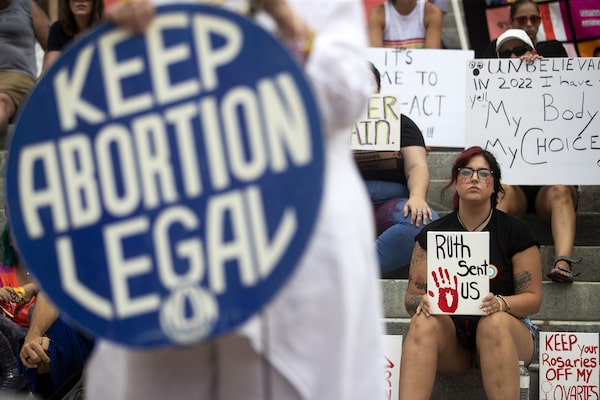
Protesters hold signs as Barbara DeVane, of the Tallahassee National Organization for Women, speaks outside the Florida Historic Capitol, June 24, 2022, in Tallahassee, Fla., during a rally protesting the Supreme Court's overturning of Roe v. Wade.Chasity Maynard/The Associated Press
Florida at this time of year undergoes great changes. The current of cool air is disappearing from the morning breezes. The begonias and impatiens are blooming. The Canadian snowbirds are packing their belongings and heading north.
This year, there is an additional change. In the sunshine state, the hopes of the Democrats, who have lost eight of the last 11 presidential contests here – including the overtime election of 2000 and the two times Donald Trump has been on the ballot – are blossoming, too, like zinnias in the backyard garden.
Indeed, the Joe Biden campaign is speaking bravely and openly about winning the 30 electoral votes of Florida, which almost certainly would give the Democrats the autumn harvest of four of the five largest states – all except Texas. It also would be a stunning repudiation of both Republican Governor Ron DeSantis, who is serving his second term in the governor’s mansion in Tallahassee, and Mr. Trump, who nearly five years ago changed his official domicile from New York to Florida, where he lives in his Mar-a-Lago retreat.
“It’s possible,” Justin Sayfie, who was a spokesman for former Republican Governor Jeb Bush and has ties to Mr. Trump, said in an interview, “that Florida could be winnable for Biden.”
Here’s what’s changed: The Democrats see new opportunity in the state’s new six-week abortion restrictions, affirmed last week and reviled by suburban women who are a major voting group. A November referendum on that regulation – and a separate one on legalizing recreational marijuana – have the possibility of driving a swarm of younger voters, repelled by the conservative social policies of the Republicans, to the voting booths. The mortifying collapse of the presidential ambitions of Mr. DeSantis, who withdrew even before New Hampshire voters headed to the polls during the January primary, has taken the sting out of the Governor’s power.
Arizona abortion ruling upends legal and political landscape from Phoenix to Washington
From its start as a colony, Florida has been shaped by massive waves of change. It is the site of St. Augustine, the first European settlement in the United States, dating to 1565. Its citrus crop, first introduced by the Spaniards, was devastated by the Great Freeze of 1894 but roared back by 1915 and orange juice remained part of the state’s identity until crop diseases, hurricanes and the creep of housing and retail development, combined with health-conscious resistance to sugary drinks, led to the decline of OJ consumption. Scores of investors regularly have made and lost fortunes investing in real estate since the first boom and bust in the 1920s.
A state where the Democrats in 1892 banned Blacks from voting in their primary now counts more than a third of registered voters as minorities. In the middle of the last century, Florida had 2.5 million residents. Now, near the one-quarter mark of the new century, its population, at 22.2 million, has grown by a factor of nearly 10.
The state, like all of the Old Confederacy, once was a Democratic redoubt. From 1875 until 1968, Florida did not elect a single Republican to the Senate, and from 1877 to 1967, no Republican occupied the governor’s chair. But today the Governor, both senators, and 20 of the 28 members of the House of Representatives are Republicans. And on Saturday, Mr. Trump raised more than US$50.5-million at his “Inaugural Leadership Dinner” in Palm Beach – the biggest one-event campaign funding haul in history.
“The Democrats clearly can close the gap with the Republicans,” said Mac Stipanovich. A former chief of staff to Republican Governor Bob Martinez, Mr. Stipanovich formerly worked on Jeb Bush’s 1998 gubernatorial campaign before abandoning the party because of his disdain for Mr. Trump. “But it remains a considerable gap.”
Still, the Democrats, who lost the state by nearly 400,000 votes four years ago, are newly invigorated. Last week three of those Democratic members of the House introduced legislation on Capitol Hill to rename a Miami prison the Donald Trump Federal Correctional Institution. Though that measure has no chance of winning House approval, Democrats are harbouring great hopes for the November election – and beyond.
“I don’t think Florida is forever Republican red,” said Susan MacManus, a University of South Florida political scientist. “This election will be closer than 2020. But the Democrats are going to have to mobilize and turn out younger voters. They have a lot to do if they’re going to run the kind of grassroots mobilization it will take to win, and that takes a lot of money.”
That is a big challenge for a state party where the outlook and party infrastructure is stuck in a faraway past and where the leadership has scant idea of how to communicate with the three-fifths of the state’s population that is part of the most recent three demographic groups. But the raw materials of a Democratic surge are present.
Chief among them is the November referendum, which would permit abortions through fetal viability, which would essentially restore the criteria of the landmark 1973 Roe v Wade Supreme Court ruling that was overturned two years ago.
“Moderate and liberal women will be excited to go to the polls to overturn the six-week abortion ban,” Mr. Sayfie said. “And the marijuana question also could help the Democrats. The two factors combined are more powerful than the prospect of a second Joe Biden term to rally people to go to the polls. But the result is that they could boost voter turnout and make for a competitive presidential race.”
 David Shribman
David Shribman